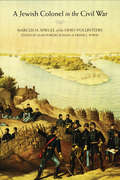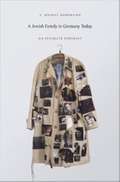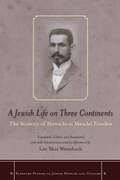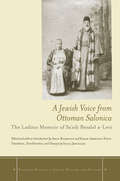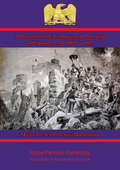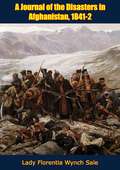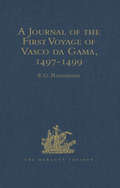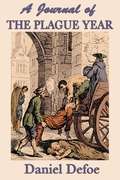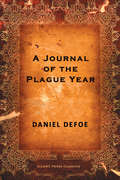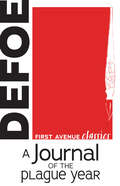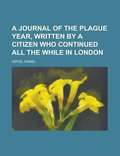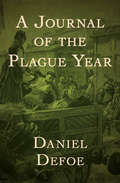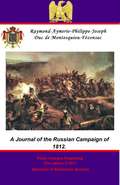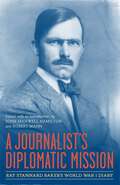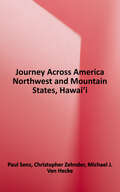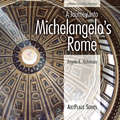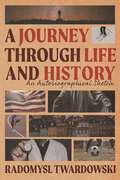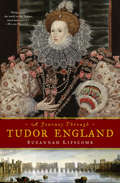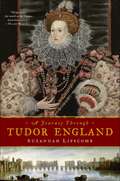- Table View
- List View
A Jewish Colonel in the Civil War: Marcus M. Spiegel of the Ohio Volunteers
by Marcus M. Spiegel Jean Powers Soman Frank L. ByrneMarcus Spiegel, a German Jewish immigrant, served with the 67th and 120th Ohio Volunteer regiments during the Civil War. He saw action in Virginia, Mississippi, Arkansas, and Louisiana, where he was fatally wounded in May 1864. These letters to Caroline, his wife, reveal the traumatizing experience of a soldier and the constant concern of a husband and father.
A Jewish Family in Germany Today: An Intimate Portrait
by Y. Michal BodemannImmediately after the Holocaust, it seemed inconceivable that a Jewish community would rebuild in Germany. What was once unimaginable has now come to pass: Germany is home to one of Europe's most vibrant Jewish communities, and it has the fastest growing Jewish immigrant population of any country in the world outside Israel. By sharing the life stories of members of one Jewish family--the Kalmans--Y. Michal Bodemann provides an intimate look at what it is like to live as a Jew in Germany today. Having survived concentration camps in Poland, four Kalman siblings--three brothers and a sister--were left stranded in Germany after the war. They built new lives and a major enterprise; they each married and had children. Over the past fifteen years Bodemann conducted extensive interviews with the Kalmans, mostly with the survivors' ten children, who were born between 1948 and 1964. In these oral histories, he shares their thoughts on Judaism, work, family, and community. Staying in Germany is not a given; four of the ten cousins live in Israel and the United States. Among the Kalman cousins are an art gallery owner, a body builder, a radio personality, a former chief financial officer of a prominent U. S. bank, and a sculptor. They discuss Zionism, anti-Semitism, what it means to root for the German soccer team, Schindler's List, money, success, marriage and intermarriage, and family history. They reveal their different levels of engagement with Judaism and involvement with local Jewish communities. Kalman is a pseudonym, and their anonymity allows the family members to talk with passion and candor about their relationships and their lives as Jews.
A Jewish Life on Three Continents: The Memoir of Menachem Mendel Frieden
by Lee Shai WeissbachThis remarkable memoir by Menachem Mendel Frieden illuminates Jewish experience in all three of the most significant centers of Jewish life during the late nineteenth and early twentieth centuries. It chronicles Frieden's early years in Eastern Europe, his subsequent migration to the United States, and, finally, his settlement in Palestine in 1921. The memoir appears here translated from its original Hebrew, edited and annotated by Frieden's grandson, the historian Lee Shai Weissbach. Frieden's story provides a window onto Jewish life in an era that saw the encroachment of modern ideas into a traditional society, great streams of migration, and the project of Jewish nation building in Palestine. The memoir follows Frieden's student life in the yeshivas of Eastern Europe, the practices of peddlers in the American South, and the complexities of British policy in Palestine between the two World Wars. This first-hand account calls attention to some often ignored aspects of the modern Jewish experience and provides invaluable insight into the history of the time.
A Jewish Renaissance in Fifteenth-Century Spain (Jews, Christians, and Muslims from the Ancient to the Modern World #37)
by Mark D. MeyersonThis book significantly revises the conventional view that the Jewish experience in medieval Spain--over the century before the expulsion of 1492--was one of despair, persecution, and decline. Focusing on the town of Morvedre in the kingdom of Valencia, Mark Meyerson shows how and why Morvedre's Jewish community revived and flourished in the wake of the horrible violence of 1391. Drawing on a wide array of archival documentation, including Spanish Inquisition records, he argues that Morvedre saw a Jewish "renaissance." Meyerson shows how the favorable policies of kings and of town government yielded the Jewish community's demographic expansion and prosperity. Of crucial importance were new measures that ceased the oppressive taxation of the Jews and minimized their role as moneylenders. The results included a reversal of the credit relationship between Jews and Christians, a marked amelioration of Christian attitudes toward Jews, and greater economic diversification on the part of Jews. Representing a major contribution to debates over the Inquisition's origins and the expulsion of the Jews, the book also offers the first extended analysis of Jewish-converso relations at the local level, showing that Morvedre's Jews expressed their piety by assisting Valencia's conversos. Comparing Valencia with other regions of Spain and with the city-states of Renaissance Italy, it makes clear why this kingdom and the town of Morvedre were so ripe for a Jewish revival in the fifteenth century.
A Jewish Voice from Ottoman Salonica
by Aron Rodrigue Sarah Abrevaya SteinThis book presents for the first time the complete text of the earliest known Ladino-language memoir, transliterated from the original script, translated into English, and introduced and explicated by the editors. The memoirist, Sa'adi Besalel a-Levi (1820–1903), wrote about Ottoman Jews' daily life at a time when the long-ascendant fabric of Ottoman society was just beginning to unravel. His vivid portrayal of life in Salonica, a major port in the Ottoman Levant with a majority-Jewish population, thus provides a unique window into a way of life before it disappeared as a result of profound political and social changes and the World Wars. Sa'adi was himself a prominent journalist and publisher, one of the most significant creators of modern Sephardic print culture. He was also a rebel, accusing the Jewish leadership of Salonica of being corrupt, abusive, and fanatical; that leadership, in turn, excommunicated him from the Jewish community. The experience of excommunication pervades Sa'adi's memoir, which documents a world that its author was himself actively involved in changing.
A Jogadora Aposta Seu Barão (Série Craven House - Volume 4 #4)
by Christina McKnightApostas dão errado quando o amor está nas cartas APOSTAS DÃO ERRADO Payton Samuels sempre soube que desejava mais da vida do que ser a filha mais nova da família mais desonrosa da cidade. Enquanto seus irmãos se contentavam em apostar sua futura felicidade no casamento, Payton aprendera, desde cedo, com a mãe que o amor é passageiro e leva apenas ao desapontamento. Tem um plano diferente: trabalhará como preceptora para os filhos do Barão Ashford, mas apenas o suficiente para ganhar sua fortuna em uma de suas infames festas de máscaras. Quando perde muito, Payton vê sua chance de ter uma vida independente em perigo - até que Lord Ashford a surpreende pagando suas dívidas. QUANDO O AMOR ESTÁ NAS CARTAS. Desde a morte trágica de sua esposa, Damon Kinder, Lord Ashford, tem sido um homem feito de gelo. Sua determinação de nunca mais ser ferido pelo amor é tão profunda que nem consegue se conectar com os próprios filhos. Quando eles rapidamente se apegam a Payton, ele acredita que encontrou uma solução: ela lhes dará o carinho e o apoio que ele não pode dar. Como passa mais tempo em torno de Payton, seu coração começa a descongelar, e ele não consegue parar de pensar na cativante preceptora. Mas todo jogador experiente sabe que, eventualmente, a sorte se esgota. Duas almas tão machucadas por amores do passado podem forjar um novo futuro juntos?
A Journal of the Campaign in Portugal and Spain
by Major-General Henry MackinnonThis ebook is purpose built and is proof-read and re-type set from the original to provide an outstanding experience of reflowing text for an ebook reader. The body of Major-General Mackinnon now lies in St. Paul's Cathedral in London, next to his brother officer Major-General Robert Craufurd, both casualties of the assault on Cuidad Rodrigo during the Peninsular War. Mackinnon left behind his private journal filled with the details of the scenery, manners, customs and people of both Spain and Portugal as he found them during the Peninsular War, right up until his death. The journal was only intended for perusal by his closest family, but bears closer examination by those interested in the Peninsular War. Title - A Journal of the Campaign in Portugal and Spain Sub-Title - Containing Remarks on the Inhabitants, Customs, Trade and Cultivation, of those Countries, From the Year 1809 to 1812. Author -- Major-General Henry Mackinnon (????-1812) Text taken, whole and complete, from the edition published in 1907, London, by Longmans and Green. Original - iii and 102 pages.
A Journal of the Disasters in Afghanistan, 1841-2
by Lady Florentia Wynch SaleDuring the First Anglo-Afghan War, Lady Florentia Sale, wife of a British army officer, Sir Robert Henry Sale, was kidnapped in 1842, along with other women and children, as well as soldiers, and detained for nine months. The group were taken hostage by Akbar Khan, following the massacre in the Khurd Karbul Pass. Amongst the hostages with Lady Sale was her youngest daughter Alexandrina, Alexandrina’s husband Lt. John Sturt, and their newborn daughter. Sturt was fatally injured by three dagger wounds to the abdomen, with Lady Sale nursed her son-in-law in his final hours. She bribed the Afghan officers into releasing them, and they were rescued by Sir Richmond Shakespear on 17 September 1842. Her courageous and defiant actions meant that she endangered herself frequently; she was shot in the wrist, with the bullet lodging there.Throughout her time as a captive, Lady Sale kept a diary, detailing the events of the ordeal. A year later, Lady Sale published her journal as A Journal of the Disasters in Afghanistan, 1841-2, which documented her experiences throughout the Afghan War, and the book received critical acclaim.An action-filled story of folly, indecision, treachery and tragedy, all the while testifying to great courage and fortitude.
A Journal of the First Voyage of Vasco da Gama, 1497-1499 (Hakluyt Society, First Series #99)
by E. G. RavensteinTranslated and Edited, with Notes, an Introduction and Appendices. Includes also letters of King Manuel and Girolamo Sernigi, 1499, and early seventeenth-century Portuguese accounts of da Gama's first voyage. This is a new print-on-demand hardback edition of the volume first published in 1898. Owing to technical constraints it has not been possible to reproduce the following maps which appeared in the first edition: 'Natal to Malinde', 'The West Coast of India', 'Africa, from the Cantino Chart', 'Africa and India, from Canerio's Chart', and 'The Indian Ocean, according to the "Mohit"'.
A Journal of the Plague Year
by Daniel DefoeClassic 1722 account of the epidemic that ravaged England nearly 60 years earlier. Defoe used his considerable talents as a journalist and novelist to reconstruct -- historically and fictionally -- the Great Plague of London in 1664-65. Written as an eyewitness report, the novel abounds in memorable and realistic details.
A Journal of the Plague Year
by Daniel DefoeA London narrator recounts both the personal and the political happenings of a single year during the Great Plague in the seventeenth century.
A Journal of the Plague Year
by Daniel Defoe'The most reliable and comprehensive account of the Great Plague that we possess' Anthony Burgess In 1665 the plague swept through London, claiming over 97,000 lives. Daniel Defoe was just five at the time of the plague, but he later called on his own memories, as well as his writing experience, to create this vivid chronicle of the epidemic and its victims. 'A Journal' (1722) follows Defoe's fictional narrator as he traces the devastating progress of the plague through the streets of London. Here we see a city transformed: some of its streets suspiciously empty, some - with crosses on their doors - overwhelmingly full of the sounds and smells of human suffering. And every living citizen he meets has a horrifying story that demands to be heard.
A Journal of the Plague Year (First Avenue Classics ™)
by Daniel DefoeFirst published in 1722, this unabridged edition of Daniel Defoe's A Journal of the Plague Year covers events in London, England, in 1665 as the bubonic plague spread throughout the city. Though a work of historical fiction, the book includes accurate historical details, charts, statistics, and government documents. Defoe's narrator follows the spread of the plague and relates how powerful families and government officials tried to hide the disease to avoid inconvenience and public panic. But as deaths mounted and fear spread, those who could began to flee the city. A Journal of the Plague Year continues to resonate with modern audiences through its parallels to issues caused by modern diseases and the COVID-19 pandemic.
A Journal of the Plague Year / Written by a Citizen Who Continued All the While in London
by Daniel DefoeThis novel is an account of one man's experiences of the year 1665, in which the Great Plague or the bubonic plague struck the city of London. The book is told somewhat chronologically, though without sections or chapter headings. <P> <P> Presented as an eyewitness account of the events at the time, it was written in the years just prior to the book's first publication in March 1722. Defoe was only five years old in 1665, and the book itself was published under the initials H. F. and is probably based on the journals of Defoe's uncle, Henry Foe. In the book, Defoe goes to great pains to achieve an effect of verisimilitude, identifying specific neighborhoods, streets, and even houses in which events took place. Additionally, it provides tables of casualty figures and discusses the credibility of various accounts and anecdotes received by the narrator. The novel is often compared to the actual, contemporary accounts of the plague in the diary of Samuel Pepys. Defoe's account, which appears to include much research, is far more systematic and detailed than Pepys's first-person account.
A Journal of the Plague Year: Written By A Citizen Who Continued All The While In London...
by Daniel DefoeDefoe&’s gripping fictionalized account of the plague that racked seventeenth-century London The year is 1665 and the plague has come to London. The air is heavy with death, the body count is rising, and the death carts are filling quickly. Our unflinching eyewitness narrator, HF, recounts the gruesome realities of life in a city overrun by the Black Death. Terror and hysteria seize the city as disease runs rampant. Blending fiction with journalism, Defoe re-creates the plague in all its horrifying detail. First published in 1722, A Journal of the Plague Year is one of the most chilling accounts of the plague ever written. This ebook has been professionally proofread to ensure accuracy and readability on all devices.
A Journal of the Russian Campaign of 1812.
by Pickle Partners Publishing Général Raymond-Aymerie-Philippe-Joseph, Duc de Montesquiou-Fézensac General Sir William Thomas KnollysThis ebook is purpose built and is proof-read and re-type set from the original to provide an outstanding experience of reflowing text for an ebook reader. An acclaimed classic of the many memoirs to have survived from the epic, tragic and disastrous Russian Campaign of 1812. This translation is taken from chapters of Fézensac's larger memoir - Souvenirs Militaires de 1804 a 1815 par le duc de Fezensac, Paris, 1863. The author starts the campaign as an aide-de-camp attached to the General Staff, and is slightly more insulated to the horrors of the march to Moscow, although glimpses of the hardships reach even the higher reaches of command. Later, after the fire and sack of Moscow, he takes command of regiment of infantry and it is then that the truly epic struggles the men undertook against their principal nature on the retreat from Moscow. His regiment forms part of Maréchal Ney's dwindling, over-worked, staving rearguard, and is witness to its trials and Homeric travails including the crossings of the Dneiper and Berezina. This edition is introduced by a withy summation of the campaign by General Knollys, who without impinging on the narrative, gives a good overall account of the campaign leaving the details of Fézensac's experiences to be brought out in his own words. Raymond-Aymerie-Philippe-Joseph de Montesquiou-Fézensac, born in Paris in 1784 into an ancient noble family, a cadet branch of the House of Gascony, he volunteered as a private soldier in 1803. He achieved rapid promotion in the campaigns of 1805 and 1806, and later serving as Maréchal Ney's aide-de-camp. His promotion would not have been hampered by his marriage to Mademoiselle Clarke, daughter of the Minister of War, General Clarke who held this post the majority of the Empire, also played a pivotal role in the fall of Paris and Napoleon's abdication in 1814. Created a baron of the empire by Napoleon, he had been promoted to the rank of chef d'escadron by the time of the 1812 Russian campaign. He was promoted to général de brigade in 1813 during the German campaign of 1813 but did not rally to Napoleon during the Hundred Days. He was elevated to the title of comte in 1817 and duc in 1821. The text is taken from the edition published in 1852 by Parker, Furnivall, and Parker, London Author: Raymond-Aymerie-Philippe-Joseph de Montesquiou-Fézensac 1784-1867 Translator and Introduction: General Sir William Thomas Knollys 1797-1883
A Journalist's Diplomatic Mission: Ray Stannard Baker's World War I Diary (From Our Own Correspondent)
by Robert Mann John Maxwell HamiltonAt the height of World War I, in the winter of 1917--1918, one of the Progressive era's most successful muckracking journalists, Ray Stannard Baker (1870--1946), set out on a special mission to Europe on behalf of the Wilson administration. While posing as a foreign correspondent for the New Republic and the New York World, Baker assessed public opinion in Europe about the war and postwar settlement. American officials in the White House and State Department held Baker's wide-ranging, trenchant reports in high regard. After the war, Baker remained in government service as the president's press secretary at the Paris Peace Conference, where the Allied victors dictated the peace terms to the defeated Central Powers. Baker's position gave him an extraordinary vantage point from which to view history in the making. He kept a voluminous diary of his service to the president, beginning with his voyage to Europe and lasting through his time as press secretary. Unlike Baker's published books about Wilson, leavened by much reflection, his diary allows modern readers unfiltered impressions of key moments in history by a thoughtful inside observer.Published here for the first time, this long-neglected source includes an introduction by John Maxwell Hamilton and Robert Mann that places Baker and his diary into historical context.
A Journey Across America: The Northwest And Mountain States, Hawai'i
by Paul SenzThis volume tells the story of the accomplishments and failures of nations, groups, and individuals, both Catholic and non-Catholic. This text remains true to the vision of history outlined in the Second Vatican Council’s guiding document, Lumen Gentium, “The Light to the Nations.” It also fills a void in the historical education of young people today, who know little or nothing of the contributions of past ages to our civilization and Church. This vacuum of historical knowledge is not our true heritage. Ours is a culture of life and of hope, of faith, vast and deep, and rich achievements for the common good. May this textbook be one step toward the full restoration of that culture.
A Journey Into Michelangelo's Rome
by Angela K NickersonFrom St. Peter's Basilica to the Capitoline Hill, this unique resource-part biography, part history, and part travel guide-provides an intimate portrait of the relationship between Michelangelo and the city he restored to artistic greatness. Lavishly illustrated and richly informative, this travel companion tells the story of Michelangelo's meteoric rise, his career marked by successive artistic breakthroughs, his tempestuous relations with powerful patrons, and his austere but passionate private life. Providing street maps that allow readers to navigate the city and discover Rome as Michelangelo knew it, each chapter focuses on a particular work that amazed Michelangelo's contemporaries and modern tourists alike.
A Journey Through Economic Time: A Firsthand View
by John Kenneth GalbraithA renowned economist presents an accessible, far-reaching history of the century's economics from World War I and the Russian Revolution, through the Depression and Keynesian theory, to colonialism's collapse and the rise of the Third World.
A Journey Through Economics: On Prosperity, Digitalization, and Justice
by Detlef PietschAnyone who does not know the history of economics cannot think competently about the future of economics. This book offers an introduction to economic history for those looking for more than just dry theory. The author takes you on a journey through the economy, from its beginnings in the Stone Age to the digitalization of modern times. In addition to the nature and fundamental principles of economics, the book also introduces great thinkers such as Aquinas, Keynes, and Erhard. While ancient philosophers like Plato and Aristotle focused mainly on the ethical dimension of economics, the first modern economist and moral philosopher, Adam Smith, for example, pondered how nations could achieve prosperity. Today, however—in an era where capitalism is increasingly under scrutiny—the question is how prosperity can reach everyone, especially in times of digitalization. Therefore, the book not only addresses economic concepts of the past and present but also offers an intriguing look into the future. Issues of social justice are discussed alongside topics such as digitalization, globalization, and ecology. The second edition has been updated to include a chapter on "Economics in Uncertain Times," which deals, among other things, with the economic consequences of the COVID-19 pandemic and the war in Ukraine.
A Journey Through Greek Mythology
by Monica CyrinoA Journey through Greek Mythology is a guidebook intended to accompany students in an introductory Greek mythology course. This guidebook serves as a practical and versatile introduction to the study of the major Greek gods and heroes, as it lays the groundwork for an exploration of the representation, interpretation, and influence of the classical Greek myths. Using this guidebook, students are able to consider how the gods and heroes functioned as objects of deep religious awe and reverence for the ancient Greeks, and yet at the same time how they were portrayed as colorful, unpredictable, subjectively "anthropomorphic" characters in the popular art and literature of classical antiquity. The guidebook offers an opportunity for students to investigate how archetypal figures and narratives emerge in Greek mythology and how these patterns develop in different representational media and literary genres. The guidebook also encourages students to discover how the Greek myths continue to influence our contemporary culture today.
A Journey Through Life and History: An Autobiographical Sketch
by Radomysl Twardowski&“...an evocative autobiographical exploration of personal growth, resilience, and cultural identity…a compelling read for those interested in autobiographical tales that blend historical context with personal reflection.&” – Readers FavoriteRadomysl Twardowski's moving story of growing up in post-war Poland begins with early memories of walks around Krakow with his beloved Grandfather Karol. As it becomes clear to the young Rado that Poland's history is rooted in Christianity, the solemn grandeur and religious atmosphere of places like Wawel Cathedral and other churches begin to have a profound impact on him. He would later be drawn to SSPX and Latin Mass, a subject of debate in the Catholic Church after the Second Vatican Council. After the rise of Solidarity in 1980 and the declaration of martial law in 1981, Rado leaves Poland for the US, where he graduates from medical school and practices cardiology for several years, eventually becoming a proponent for fitness and wellness. Woven throughout this gripping memoir set against the backdrop of dramatic political, religious, and newsworthy developments are the author's stories of hardship and triumph over adversity-from a skiing injury at age twelve that left him with physical limitations to the dissolution of his marriage and a difficult separation from his children. Throughout this memorable journey through history, Twardowski offers us a deeply personal life story of exploration, loss, redemption, and survival.
A Journey Through Tudor England: Hampton Court Palace and the Tower of London to Stratford-upon-Avon and Thornbury Castle
by Suzannah LipscombUsing place as a lens through which to view history, come take a vivid and captivating journey through England's most vibrant eraFor the armchair traveler or for those looking to take a trip back to the colorful time of Henry VIII and Thomas Moore, A Journey Through Tudor England takes you to the palaces, castles, theatres and abbeys to uncover the stories behind this famed era. Suzannah Lipscomb visits over fifty Tudor places, from the famous palace at Hampton Court, where dangerous court intrigue was rife, to less well-known houses such as Anne Boleyn's childhood home at Hever Castle, or Tutbury Castle, where Mary, Queen of Scots, was imprisoned. In the corridors of power and the courtyards of country houses, we meet the passionate but tragic Katheryn Parr, Henry VIII's last wife; Lady Jane Grey, the nine-day queen; and we come to understand how Sir Walter Raleigh planned his trip to the New World. Through the places that defined them, this lively and engaging book reveals the rich history of the Tudors and paints a vivid and captivating picture of what it would have been like to live in Tudor England.
A Journey Through Tudor England: Hampton Court Palace and the Tower of London to Stratford-upon-Avon and Thornbury Castle
by Suzannah LipscombUsing place as a lens through which to view history, come take a vivid and captivating journey through England's most vibrant eraFor the armchair traveler or for those looking to take a trip back to the colorful time of Henry VIII and Thomas Moore,A Journey Through Tudor England takes you to the palaces,castles, theatres and abbeys to uncover the stories behind this famed era. Suzannah Lipscomb visits over fifty Tudor places, from the famous palace at Hampton Court, where dangerous court intrigue was rife, to less well-known houses such as Anne Boleyn&’s childhood home at Hever Castle, or Tutbury Castle, where Mary Queen of Scots was imprisoned.In the corridors of power and the courtyards of country houses, we meet the passionate but tragic Katheryn Parr, Henry VIII&’s last wife; Lady Jane Grey, the nine-day queen; and come to understand how Sir Walter Raleigh planned his trip to the New World. Through the places that defined them, this lively and engaging book reveals the rich history of the Tudors and paints a vivid and captivating picture of what it would have been like to live in Tudor England. 16 pages of B&W and color photographs
